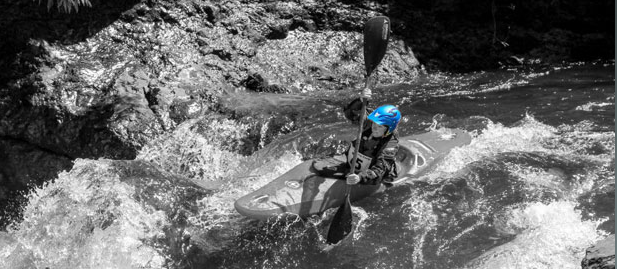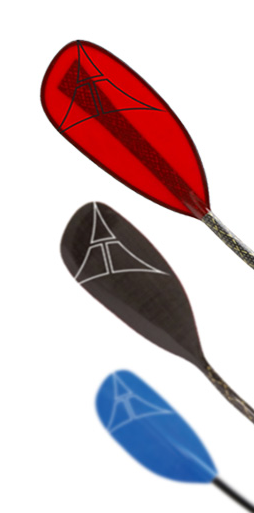As a whitewater kayaker, it’s just as important to choose the right paddle as it is the right kayak. The paddle becomes an extension of your body, so it’s only logical to choose one that is comfortable in your hands, and feels good! If only it were that simple: what about all the different blades designs? Should you choose carbon fiber or fiberglass? How long should it be? Should you paddle a straight or bent shaft?
While designs vary slightly, the general anatomy of the paddle is the same: two blades attached to either a straight or bent shaft. The blades typically have a slightly concave power face, and a slightly convex or flat back. Whitewater paddle blades and shafts come in a variety of materials: wood, plastic, fiberglass, carbon, carbon/kevlar, etc. and a variety of sizes: generally anywhere from 188cm to 200cm long.
Length: Generally, for a do-it-all paddle, I would suggest the following, if you are:
5’0″-5’3″: 188-192cm
5’3″-5’8″: 192-196cm
5’8″-6’1″: 196-200cm
6’1″ + : 200-204cm
If you are a smaller paddler, consider a shorter paddle with a smaller shaft, and smaller blades. The larger the blades/paddle, the more effort and strength needed to control the paddle. Therefore, using a paddle that is too long or too large will cost you some control and could put an undue amount of wear and tear on your body.
Style of Paddling:Â Generally, I suggest a shorter paddle for playboating, and a longer paddle for creeking. When playboating, you are regularly transferring your paddle from one side of your boat to the other (ie: cartwheeling), and a long paddle can get “hung-up” so to speak.When creeking, the more leverage the better, and generally, you’ll like the added reach of a longer paddle when creeking. Just my .02 cents… If you want one paddle that can do it all, go somewhere in between on sizes. I am 5’5″, and paddle a 191cm when playboating, and a 194cm paddle when creeking.
Straight vs. Bent Shaft: The straight-shaft is a more traditional design, while the bent-shaft is a newer, more ergonomically correct design. I suggest a bent shaft whenever possible, as it puts your wrists, elbows, and therefore shoulders in a more neutral position, allowing for less stress/strain on your joints, and less fatigue while paddling.
Blade Offset: Whitewater blades typically have anywhere from 15 to 45 degrees of offset. The less the blades are offset, the less movement occurs at the wrist, meaning less repetitive twisting, and less wear and tear on the joints. This means less fatigue on the water, and fewer injuries. I would personally recommend a blade offset of 30 degrees.
Materials:
Paddle blades and paddle shafts come in all kinds of materials: aluminum, plastic, fiberglass, carbon, etc. The main differences between materials are swing-weight and strength. Aluminum is the heaviest, followed by plastic, fiberglass, and the lightest: carbon. A light paddle means you can paddle farther, and spend more time on the water before you fatigue.
Typically strength and rigidity go in that order as well, with carbon being the strongest and the stiffest. A stiff paddle generally means more efficient paddling, as your effort goes directly into the paddle stroke (it is not lost in the flex of the paddle shaft or blades).
Durability wise, it can be said more flexible paddles have more “give” causing them to break less frequently. On the other hand, overtime, this flex can cause stress fractures, which overtime can weaken the integrity of the paddle. There have been no studies done to indicate better durability in stiff paddles versus flex. In my personal experience, if you hit a plastic blade edge on a rock hard enough it will crack. A fiberglass blade will splinter, while a carbon will simply “ding”. Reason being, carbon paddles typically have some form of Dynell edging to protect the edges.
When considering the kind of paddle you want, consider the kind of paddling you are going to do, how hard you are on gear, and how important weight and durability are to you. I would suggest a paddle with either a fiberglass or carbon blades.Â
Price:Â The lighter the paddle, generally the more expensive the paddle. The price range of dependable paddles is generally $150-$500
When choosing a paddle, consider all of the above, and if you can, demo. Each paddle is a little different, and it’s worth it to find the paddle that feels good!
My paddle of choice is the Adventure Technology AT2 Flexi: Find out why
Happy Paddling,
Kim Becker



